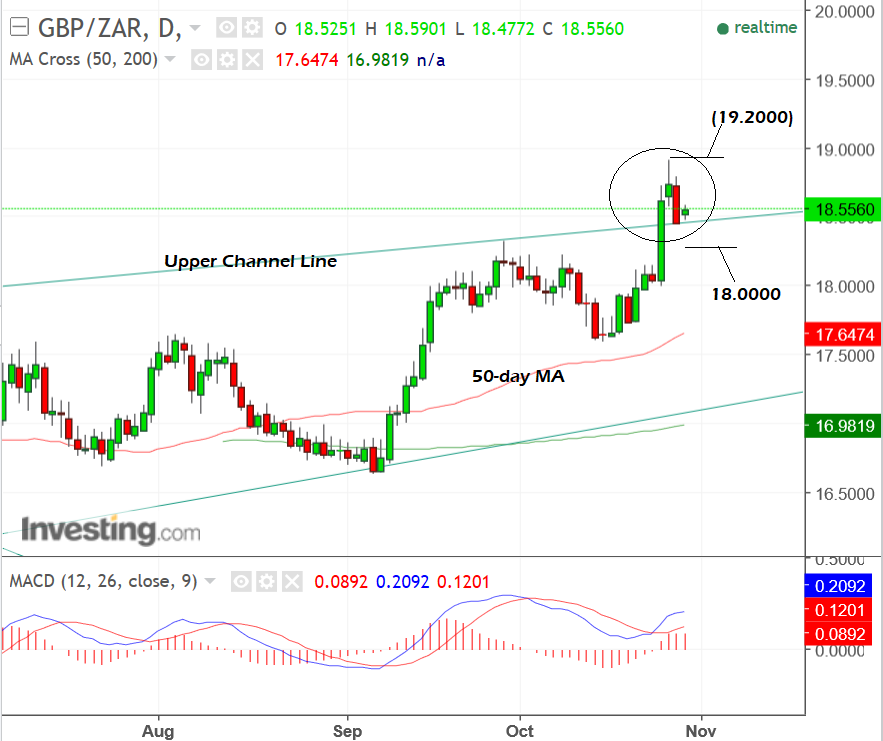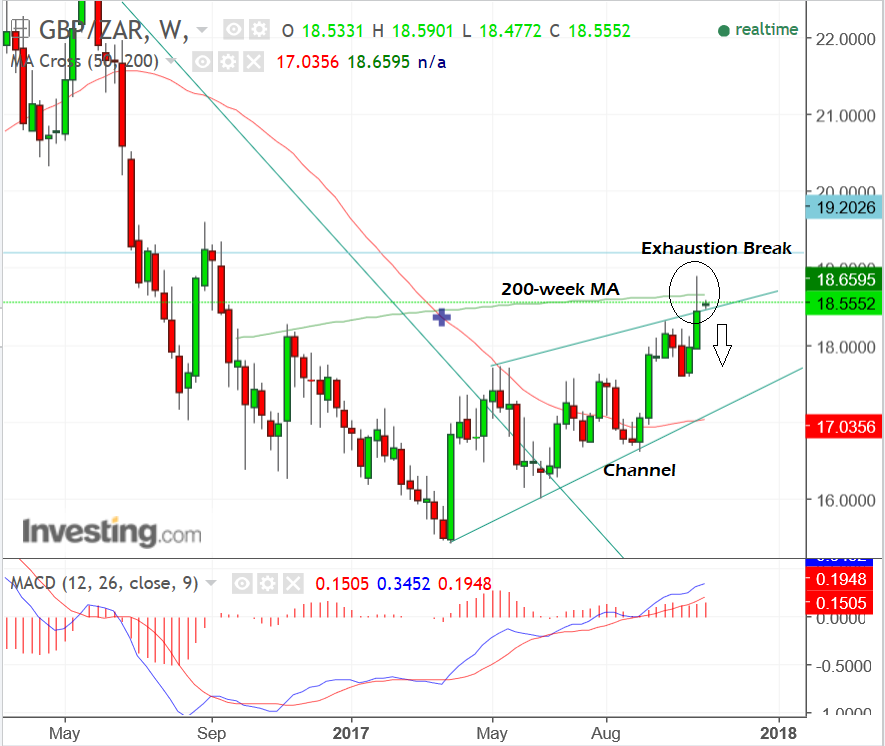Pound-to-Rand Rate May Rate Have Peaked Suggest Technicals

The South African Rand weakened substantially following last week's budget but losses may only have been temporary suggests one interpretation, backed up by several analysts views.
The Pound-to-South African Rand exchange rate has been trading in a rising channel ever since the establishment of the October lows in 2016.
Recently it accelerated higher, breaking out above the upper border of the channel in a strong up-move (circled below).
This move is probably what is known as an 'exhaustion break', which means it could be signalling the end of the uptrend.
The weekly chart shows the spike of the exhaustion break intersecting with the 200-week moving average, whilst forming a rather bearish-looking candle.
This gives the chart a bearish look-and-feel which supports the hypothesis that the breakout may have signaled exhaustion of the uptrend.
For a more convincing signal of more downside, we would ideally want to see a break below 18.3250 providing confirmation of more downside.
Though our base case is for more downside we cannot completely discount the possibility of a continuation higher either.
Yet we would want confirmation first from a breakout above Thursday's 18.9000 highs, which would then activate an initial target at 19.2000, calculated by extrapolating the move prior to the break (labeled 'a') above the break (labeled 'b').

Get up to 5% more foreign exchange by using a specialist provider by getting closer to the real market rate and avoid the gaping spreads charged by your bank for international payments. Learn more here.
South African Rand Still Adjusting to the Budget
The 'exhaustion break' on the charts corresponds with the weakness suffered by the Rand after Wednesday's budget.
The Rand weakened after the budget due to forecasts of a widening budget deficit.
This then triggered fears of a rating downgrade as soon as November when previously economists had thought there would be no chance of a downgrade until mid-2018.
Yet despite this, some analysts see last week's 'overshoot' as a temporary fall which will not last.
"It is impossible to premise where the rand should trade after the budget but this morning’s levels seem a lot more justified than Friday’s overshoot," said Rand Merchant Bank's Analyst John Cairns.
That the Rand's weakness represent's a temporary aberration is also the view of Unicredit FX Strategist Kieran Kowshik.
"We stress that in the weeks ahead, overshooting and highly volatile price action is possible, however, any blow-out weakness could eventually provide a buying opportunity in the months ahead," said Kowshik.
The possibility that Wednesday's peak is an exhaustion high and the Rand could nor start to recover, pushing GBP/ZAR lower again, is, therefore, supported by fundamental as well as technical analysis - strengthening the bearish case for the pair.
BoE Centre Stage this week for the Pound
The big event to watch in the week ahead is the Bank of England's Inflation Report and Monetary Policy Decision, due on Thursday, November 2.
Money markets are currently pricing in a 90% chance that the Bank will raise interest rates - so the immediate risk to Sterling is if they don't raise rates. In such a scenario expect the Pound to plummet.
Such a move would be unlikely however as the Bank's Monetary Policy Committee know their reputation is at stake; in short, there will be few who take the words of Governor Mark Carney and his lieutenants seriously should he not follow through with a 0.25% rate rise.
An interest rate rise on its own would be neutral, as it is well signposted. What matters is communication regarding future policy moves - is there going to be a follow-up rate rise in 2018 or not? If yes, this would be positive for Sterling, if no, this would be bearish.
Financial markets are now pricing in a rise in 2018 which is more in line with Carney's view and so he may express satisfaction that they are correctly pricing probabilities.
"The picture is still cloudy enough for some UK rate-setters to question the need for immediate action. Nevertheless, we expect the Committee to move ahead with a 0.25% increase," says Lloyds Commercial Banking's Senior Economist Rhys Herbert, adding:
"With regard to the Bank’s forward guidance, of most interest will be whether Carney reiterates his previous assertion that markets are underestimating the potential for interest rate rises."
Yet at the same time, Carney is still expected to emphasise that interest rate rises are likely to be "gradual".
The big debate for Sterling going forward is whether the interest rate is a once-and-done affair or the start of a new cycle.
Whichever side you fall on is likely to determine whether you are bullish, or bearish on Sterling.
“For investors, the key question is whether or not there will be further hikes next year. Market expectations are for at least one further 25bp hike next year. In contrast, we think the MPC will be making a mistake by hiking now, and that they will recognize this in the coming months,” says Daniel Vernazza, UK economist at UniCredit.
On the other side of the coin is the view that we are at the start of a new cycle of rate rises.
“It is not clear to us that UK growth is about to falter suddenly. There may be further Brexit negotiation uncertainty, but there is arguably a lot of it already. Instead, we prefer to trade with conviction the idea that this is not a policy mistake and that the BoE is on a hiking cycle,” says Jordan Rochester at Nomura.
As a result, Rochester is betting the Pound-to-Euro exchange rate will rise towards 1.15 near-term.
PMIs
Another major release for the Pound in the week ahead is the results of the October Purchasing Manager surveys for Manufacturing, Construction, and Services.
These are out at 9.30 on Wednesday 1, Thursday 2 and Friday 3 respectively.
Manufacturing it forecast to fall to 55.8 from 55.9 by the consensus of economists, although, some such as Lloyds's Herbert see an even lower result as likely due to the decline in the CBI Industrial Trends survey last week.
However, this is with the proviso that the Manufacturing PMI has been overall in an upbeat trend.
Lloyds Bank's Herbert is more constructive about Services PMI which he expects to come out at 54.0, however, the consensus expectation is for a fall to 53.2 from 53.6.
Finally, in the coming week Brexit Minister David Davis is to be questioned on the progress of negotiations on Tuesday at 16.05 (UK), and clearly how he answers is likely to impact the Pound given how hypersensitive the currency is to Brexit headlines.
Get up to 5% more foreign exchange by using a specialist provider by getting closer to the real market rate and avoid the gaping spreads charged by your bank for international payments. Learn more here.





